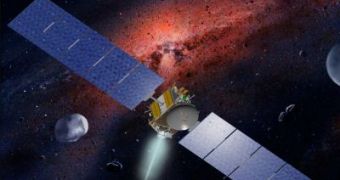NASA's Dawn spacecraft is less than year closer to finally reaching giant asteroid Vesta, as it enter its orbit in late July 2011.
The first images of the asteroid will captivate the public as it will look like it is broadcast live, says Marc Rayman, Dawn’s chief engineer at the Jet Propulsion Laboratory, cited by NASA Science.
“It will look as though the spacecraft is hovering in one place while Vesta rotates beneath it; Vesta is going to amaze us,” he said.
Several scientists look at Vesta as at a protoplanet because it was in the process of forming into a planet when Jupiter became so big that it interrupted its growth.
Because the gas giant is so massive, all material within the asteroid belt was so stirred up that it can no longer
The gas giant became so massive that its gravity stirred up the material in the asteroid belt so the objects there could no longer fuse.
So asteroid Vesta measures 350 miles across and contains almost 10% of the mass of the entire asteroid belt.
“It’s a big, rocky, terrestrial type body – more likely similar to the moon and Mercury than to the little chips of rocks we’ve flown by in the past,” explains Rayman.
It is so big that at its south pole there is a crater that contains a mountain bigger than asteroid Eros, Dawn's chief engineer adds.
The spacecraft will orbit the asteroid for a year, carrying out detailed studies and becoming the first space ship to ever orbit a body within the asteroid belt.
Christopher Russell of UCLA, the mission’s Principal Investigator, says that we can learn a lot about the way planets formed, thanks to Vesta, and that “there is a whole team of scientists sitting on the edge of their seats waiting for that first glimpse of Vesta.”
As for the approach of the asteroid, it will be quite relaxing for the mission's team members thanks to Dawn's gentle ion propulsion, that slowly spirals into its target, and gets closer and closer as it loops around.
“This may be the first planetary mission that doesn’t cause its mission team members to bite their nails while their spacecraft is getting into planetary orbit,” explains Rayman.
The spacecraft is so well adjusted that it will take only a slight change in trajectory, to allow the spacecraft to be captured by Vesta’s gravity.
As for the images that Dawn might capture, Carol Raymond, the mission’s Deputy Principal Investigator at JPL says that “we don’t expect to see active volcanoes, but there could be ancient volcanic features still recognizable among the craters.”
On the other side, Rayman says that “other sights could be completely unlike anything we’ve imagined, it’ll be pure excitement!”

 14 DAY TRIAL //
14 DAY TRIAL //